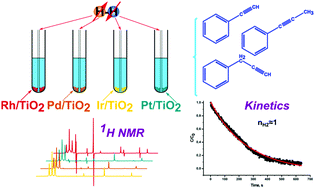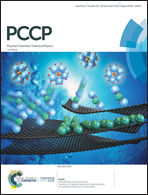Heterogeneous hydrogenation of phenylalkynes with parahydrogen: hyperpolarization, reaction selectivity, and kinetics†
Abstract
Parahydrogen-induced polarization (PHIP) is a powerful technique for studying hydrogenation reactions in gas and liquid phases. Pairwise addition of parahydrogen to the hydrogenation substrate imparts nuclear spin order to reaction products, manifested as enhanced 1H NMR signals from the nascent proton sites. Nanoscale metal catalysts immobilized on supports comprise a promising class of catalysts for producing PHIP effects; however, on such catalysts the percentage of substrates undergoing the pairwise addition route—a necessary condition for observing PHIP—is usually low. In this paper, we present a systematic study of several metal catalysts (Rh, Pt, Pd, and Ir) supported on TiO2 in liquid-phase hydrogenation of different prototypical phenylalkynes (phenylacetylene, 1-phenyl-1-propyne, and 3-phenyl-1-propyne) with parahydrogen. Catalyst activity and selectivity were found to be affected by both the nature of the active metal and the percentage of metal loading. It was demonstrated that the optimal catalyst for production of hyperpolarized products is Rh/TiO2 with 4 wt% metal loading, whereas Pd/TiO2 provided the greatest selectivity for semihydrogenation of phenylalkynes. In a study of liquid-phase hydrogenation reaction kinetics, it was shown that reaction order with respect to hydrogen is nearly the same for pairwise and non-pairwise H2 addition—consistent with a similar nature of the catalytically active sites for these reaction pathways.



 Please wait while we load your content...
Please wait while we load your content...
